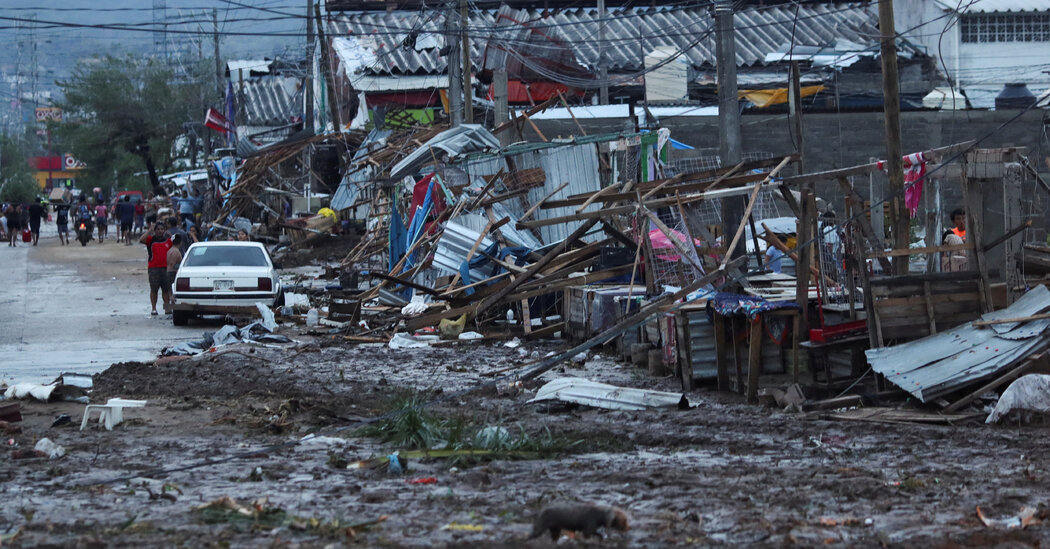Miguel Angel Dorantes sat in his empty cab on Thursday, surrounded by the devastation left by Hurricane Otis, the most powerful hurricane to hit the Pacific coast of Mexico. His hillside house in Acapulco was blocked by mudslides, and basic goods were scarce due to aggressive looting following the storm.
“We have no gas, no water, no food,” he said, as people ran past his car and other gridlocked vehicles, carrying bottles of water, bags of beans, and anything else they could find. “Everything has been looted. There’s nothing to take anymore.”
The extent of the destruction left by Hurricane Otis, which transformed the once-popular tourist destination into a scene of chaos, only started to come into view that morning. Shockingly, more than two dozen people were killed, and three were missing after the storm made landfall in the early hours of Wednesday.
Thousands of military officers, medical teams, and government officials were faced with a devastated Guerrero State on Thursday. Communication and power systems remained largely off in much of the state, making it difficult to assess the full extent of the hurricane’s toll.
“We are very sorry for the loss of 27 human beings,” President Andrés Manuel López Obrador expressed during his daily news conference in Mexico City on Thursday after visiting the disaster area. “That is what hurts the most because the material can be taken care of, and we are going to do it with great responsibility.”
The hurricane struck with little warning, growing from a tropical storm into a Category 5 hurricane with sustained winds of 165 miles per hour when it made landfall. Acapulco, a port city of over 852,000 people on the Pacific coast and the largest city in Guerrero State, was particularly affected. The city was hosting an international mining industry convention when the storm hit, and many hotels were packed with tourists.
Photographs and videos showed ravaged hotel rooms, doors ripped from hinges, and furniture scattered throughout city streets. Roughly 80 percent of hotels in Acapulco were damaged by the storm, according to Evelyn Salgado Pineda, the governor of Guerrero.
The winds ripped trees and utility poles from the ground, leaving Acapulco without power, communication, and water. Beaches that once attracted visitors from all over the world were now covered in piles of debris, and many streets had turned into rivers of mud. More than 200 patients had to be moved out of damaged hospitals, according to Rosa Icela Rodriguez, the national secretary of security and citizen protection.
The Mexican authorities deployed over 8,000 members of the armed forces to the area, but desperation was clear in Acapulco’s outer neighborhoods on Thursday. Residents carried necessities through waist-deep flooded streets, and some even resorted to looting stores. Closer to the city, people rushed to the few stores and warehouses that had not yet been ransacked.
Since the storm, efforts have been made to provide food and water to those in need, and search and rescue teams were sent to survey Acapulco and the surrounding mountainous region, which is susceptible to landslides.
However, rebuilding the damaged communities of Guerrero could face challenges made more difficult after President López Obrador overhauled Mexico’s Natural Disaster Fund. This pool of federal money for emergency relief was cut two years ago as part of budget cuts across the federal government.
By law, the fund used to receive 0.4 percent of Mexico’s federal budget every year, allowing unused funds to roll over to the next year. Now, the budget for disaster relief fluctuates annually based on other priorities, a move that has faced criticism.
President López Obrador defended his decision, referring to the fund as a “petty cash box” at the disposal of “corrupt politicians.”
Despite the challenges, Mexico is mobilizing resources to aid the affected areas. Search and rescue efforts continue, and the government is delivering food to the region by air. The resilience of the affected communities and the support of the Mexican people are critical in overcoming the aftermath of Hurricane Otis.
Otis rapidly intensified from a tropical storm to a Category 5 hurricane in less than 24 hours, shocking forecasters and the Mexican authorities. Their models failed to predict such rapid intensification, creating what was described as a “nightmare scenario” by meteorologist Eric Blake from the National Hurricane Center.


